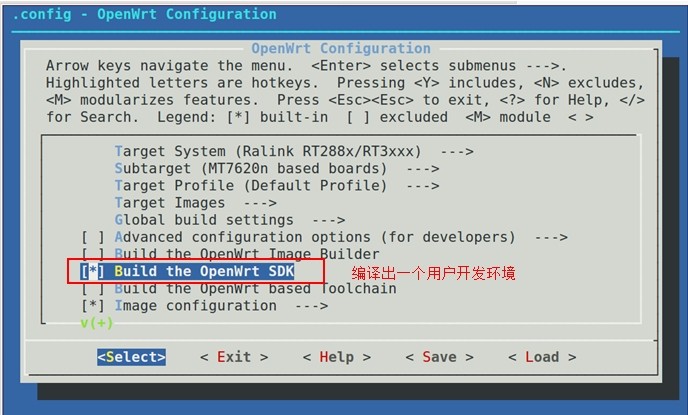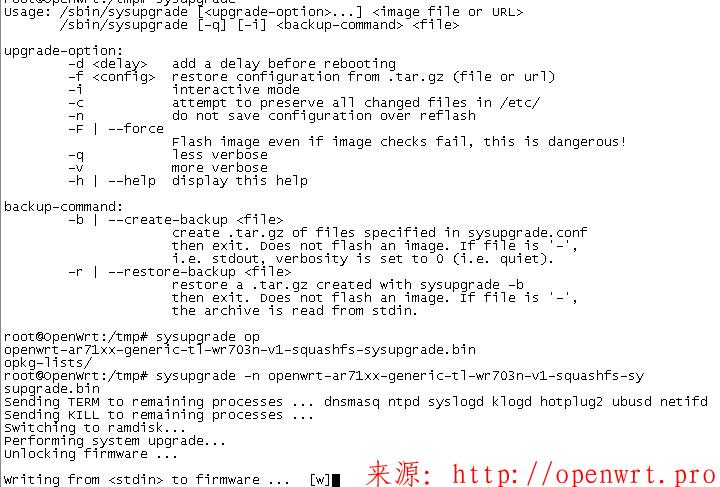1、搭建编译环境是http://cn.wrtnode.com/?p=172 文档里有详解,我们要做的就是在它基础上编译出一个自己的OpenWrt开发环境。
2、在源码的trunk目录下,执行
$ make menuconfig
选中 [*]Build the OpenWrt SDK,保存退出
$ make V=s
3、编译完成以后,在trunk/bin/ramips我们会看到OpenWrt-SDK-ramips-for-linux-x86_64-gcc-4.8-linaro_uClibc-0.9.33.2.tar.bz2 压缩包。
这个就是我们编译好的OpenWRT SDK环境。我们将在它下面来做OpenWrt软件包的开发。
下面来解析一下我们的SDK环境的含义,可以从名称上看出,target system是ramips,host system是Linux-x86_64,使用的编译工具以及库是 gcc-4.8-linaro_uClibc-0.9.33.2
4、解压,并进入SDK
$ tar -jxvf OpenWrt-SDK-ramips-for-linux-x86_64-gcc-4.8-linaro_uClibc-0.9.33.2.tar.bz2 $ cd OpenWrt-SDK-ramips-for-linux-x86_64-gcc-4.8-linaro_uClibc-0.9.33.2 $ ls
我们接下来就要在package这个目录下做操作了。
5、开发hello wrold的软件包
(1)进入package目录:
$ cd package
(2)在package目录下创建helloworld目录,并进入helloworld目录:
$ mkdir helloworld $ cd helloworld
(3)在helloworld目录下,创建新目录 src,并进入到src目录,我们要在src目录下来写我们的hellowrold.c以及编译helloworld.c所需要的Makefile文件。
$ mkdir src $ cd src $ touch helloworld.c $ touch Makefile
$ vim helloworld.c
#include <stdio.h>
#include <unistd.h>
int main(void)
{
printf("a hellowrold ipk for openwrt !!! \n");
return 0;
}$ vim Makefile # build a Makefile for hellowrold.c helloworld: helloworld.o $(CC) $(LDFLAGS) helloworld.o -o helloworld helloworld.o: helloworld.c $(CC) $(CFLAGS) -c helloworld.c clean: rm *.o helloworld
(4)编写Makefile,这个Makefile文件是给OpenWRT读的。是用来生成软件包的,在上一步中我们写的Makefile是为了编译helloworld.c的,两个Makefile不同,也不在同一层目录下。在上一步中我们是在src目录下,现在我们要编写的Makefile要在上层目录,既是helloworld目录下
$ cd ../
注: ../ 表示上一层目录
$ touch Makefile
$ vim Makefile ############################################### OpenWrt Makefile for helloworld program ############################################## include $(TOPDIR)/rules.mk # Name and release number of this package PKG_NAME:=helloworld PKG_RELEASE:=1 # This specifies the directory where we're going to build the program. # The root build directory, $(BUILD_DIR), is by default the build_mipsel # directory in your OpenWrt SDK directory PKG_BUILD_DIR := $(BUILD_DIR)/$(PKG_NAME) include $(INCLUDE_DIR)/package.mk # Specify package information for this program. # The variables defined here should be self explanatory. # If you are running Kamikaze, delete the DESCRIPTION # variable below and uncomment the Kamikaze define # directive for the description below define Package/helloworld SECTION:=utils CATEGORY:=Utilities TITLE:=Helloworld -- prints a snarky message endef # Uncomment portion below for Kamikaze and delete DESCRIPTION variable above define Package/helloworld/description If you can't figure out what this program does, you're probably brain-dead and need immediate medical attention. endef # Specify what needs to be done to prepare for building the package. # In our case, we need to copy the source files to the build directory. # This is NOT the default. The default uses the PKG_SOURCE_URL and the # PKG_SOURCE which is not defined here to download the source from the web. # In order to just build a simple program that we have just written, it is # much easier to do it this way. define Build/Prepare mkdir -p $(PKG_BUILD_DIR) $(CP) ./src/* $(PKG_BUILD_DIR)/ endef # We do not need to define Build/Configure or Build/Compile directives # The defaults are appropriate for compiling a simple program such as this one # Specify where and how to install the program. Since we only have one file, # the helloworld executable, install it by copying it to the /bin directory on # the router. The $(1) variable represents the root directory on the router running # OpenWrt. The $(INSTALL_DIR) variable contains a command to prepare the install # directory if it does not already exist. Likewise $(INSTALL_BIN) contains the # command to copy the binary file from its current location (in our case the build # directory) to the install directory. define Package/helloworld/install $(INSTALL_DIR) $(1)/bin $(INSTALL_BIN) $(PKG_BUILD_DIR)/helloworld $(1)/bin/ endef # This line executes the necessary commands to compile our program. # The above define directives specify all the information needed, but this # line calls BuildPackage which in turn actually uses this information to build a package. $(eval $(call BuildPackage,helloworld))
(5)下面就是编译了,回到SDK的顶层,也就是下面这个目录:
$ make V=s
编译过程会在build_dir目录下完成,生成的ipk包,在当前目录下的 bin/ramips/packages下的helloworld_1_ramips_24kec.ipk
(6)将helloworld_1_ramips_24kec.ipk 上传到WRTnode上
如果您是在linux下可以用scp命令来上传你的软件包,使用方法:
$ scp xxx/helloworld_1_ramips_24kec.ipk root@192.168.8.1:/usr/bin
x/ 填写你的helloworld_1_ramips_24kec.ipk 所在的目录,192.168.8.1是我的WRTnode的ip,当然这是根据你自己的WRTnode开发板的ip决定的
如果你是在windows系统下可以用winscp软件来上传到WRTnode。
(7)在WRTnode开发板上执行
$ cd /usr/bin $ opkg install helloworld_1_ramips_24kec.ipk
执行 helloworld 查看程序的效果。
$ helloworld
出现打印信息:
a hellowrold ipk for openwrt !!!
创建软件包是Makefile的详解请查阅openwrt wiki
http://wiki.openwrt.org/zh-cn/doc/devel/packages
参考文献
http://hi.baidu.com/gouooo/item/6932bfa97d23d1981410736a













